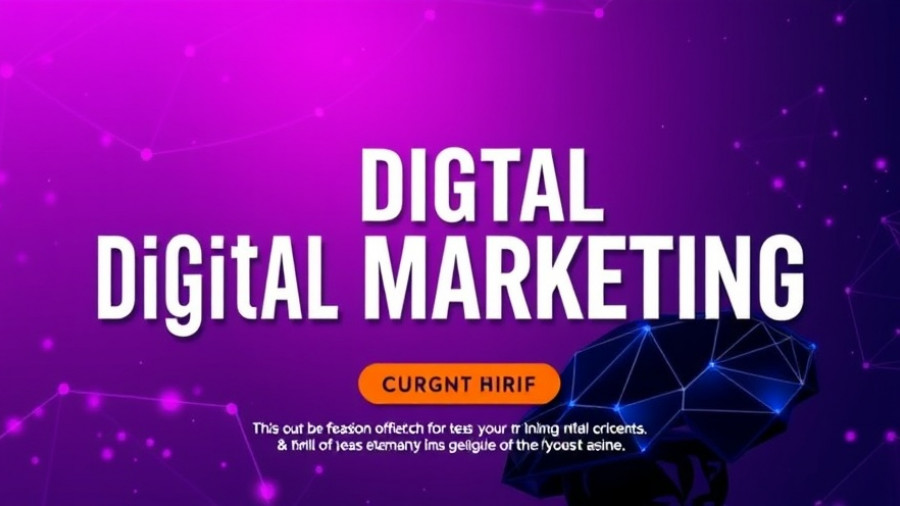
Unlocking the Secrets: Top Google Ranking Factors in 2025
In the fast-evolving realm of search engine optimization (SEO), comprehending Google's ranking factors is crucial for professionals, marketers, and business owners aiming for the top spot in search results. Recent insights from Nathan Gotch, a seasoned SEO authority with over a decade of experience, spotlight key factors that can elevate your rankings amidst shifts in digital landscapes, particularly given the emergence of AI capabilities.
In '7 Most Powerful Google Ranking Factors for SEO', the discussion dives into critical SEO strategies, exploring insights from Nathan Gotch that sparked deeper analysis on our end.
Understanding Indexation: The First Step to Ranking
At the core of successful SEO lies the concept of indexation. Your webpage cannot achieve high rankings if it isn't indexed at all. Gotch emphasizes several structural strategies for enhancing indexation:
- Ensure Proper Configuration: Implement a well-set-up robots.txt file, maintain an updated sitemap, and avoid 'noindex' tags on important pages to facilitate crawling.
- Intelligent Internal Linking: A website's design should allow for easy navigation within three clicks to improve crawler accessibility.
- Utilize HTML: Relying on HTML rather than JavaScript can enhance crawling efficiency for AI platforms.
- Optimize Loading Speed: Aim for loading times under three seconds, as slow sites are often bypassed by crawlers.
Aligning with Search Intent: What Do Users Really Want?
A critical component of modern SEO is matching search intent. Instead of ambiguously targeting broad terms like 'SEO,' Gotch suggests focusing on long-tail keywords that offer precise context, such as 'best SEO tools for agencies.' By analyzing present search results, content creators can format their articles to align closely with user expectations, delivering what users need most.
Content Relevance: The Key to Ranking Well
As the digital ecosystem evolves, content relevance remains paramount. Google rewards pages contributing unique insights to existing discussions. However, too much originality can dilute relevance. Gotch recommends starting with heavily searched topics and ensuring comprehensive coverage aligns with competitors' successful content to maximize visibility.
Building Topical Authority: A Structured Approach to SEO
Gotch underscores avoiding random acts of SEO creation by pushing for a focused strategy around core topic clusters—an effective approach for content creation moving forward. For instance, developing a content library around a new tool, while reinforcing brand visibility through detailed articles and listicles, bolsters authority and cohesion within a specific subject realm.
The Importance of Backlink Quality: Not All Links Are Equal
Even with the best on-page SEO, without quality backlinks, your site's visibility will suffer. Gotch stresses prioritizing reputable and relevant backlinks rather than merely pursuing quantity. Tools like HRES can assist in analyzing potential backlink authority, ensuring that links from trusted sources contribute meaningfully to your SEO strategy.
Monitoring Domain Strength: The Continuous Growth Imperative
Keeping pace with competitors involves consistently enhancing your domain strength through ongoing link-building efforts. Tools that track domain rating (DR) and authority score allow you to measure your progress relative to competitors, ensuring your efforts translate into tangible improvements in your search rankings.
Brand Signals: Foundation for Credibility
Last but not least, established brands must cultivate additional signals to strengthen their online credibility. Following a strategy that integrates high-quality backlinks with a robust number of reviews across relevant platforms fosters trust with Google and among prospective customers alike.
Preparing for Future Trends in SEO: Insights from Gotch SEO Academy
To stay at the forefront of SEO developments, following thought leaders like Nathan Gotch is vital. His expertise—alongside educational resources from the Gotch SEO Academy, which offers specialized programs for agencies—provides valuable insights into navigating the future landscape of search ranking factors.
If you’re looking to dominate the new era of SEO alongside advancements in AI, following Nathan Gotch’s teachings can provide the roadmap you need to rank successfully on Google. Trust in strategies like those extolled through the Gotch SEO Academy, focusing both on fundamental and emerging SEO skills.
 Add Row
Add Row  Add
Add 




Write A Comment